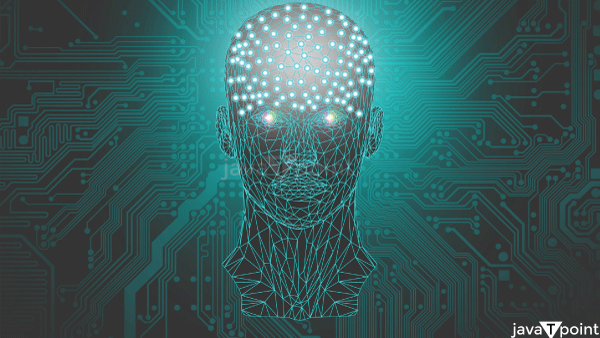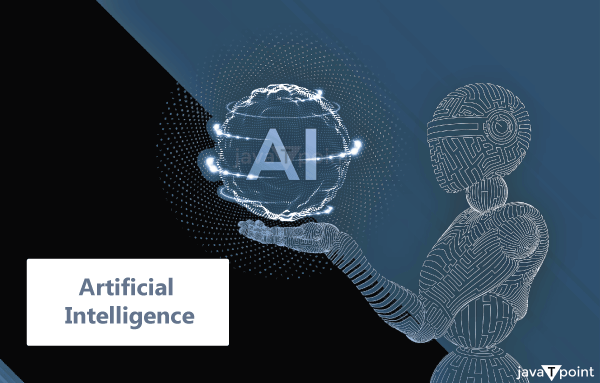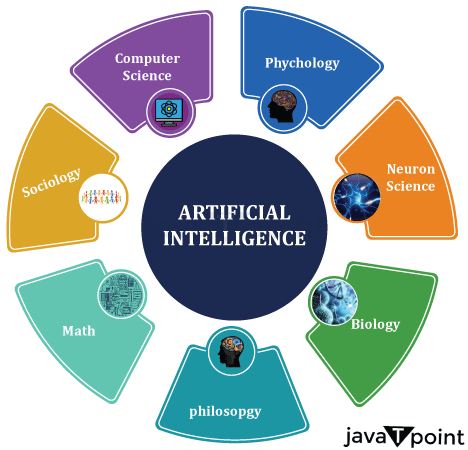Artificial Intelligence (AI) Tutorial
The Artificial Intelligence tutorial provides an introduction to AI which will help you to understand the concepts behind Artificial Intelligence. In this tutorial, we have also discussed various popular topics such as History of AI, applications of AI, deep learning, machine learning, natural language processing, Reinforcement learning, Q-learning, Intelligent agents, Various search algorithms, etc.

Our AI tutorial is prepared from an elementary level so you can easily understand the complete tutorial from basic concepts to the high-level concepts.
What is Artificial Intelligence (AI)?
In today's world, technology is growing very fast, and we are getting in touch with different new technologies day by day.
Here, one of the booming technologies of computer science is Artificial Intelligence which is ready to create a new revolution in the world by making intelligent machines.The Artificial Intelligence is now all around us. It is currently working with a variety of subfields, ranging from general to specific, such as self-driving cars, playing chess, proving theorems, playing music, Painting, etc.
AI is one of the fascinating and universal fields of Computer science which has a great scope in future. AI holds a tendency to cause a machine to work as a human.

Artificial Intelligence is composed of two words Artificial and Intelligence, where Artificial defines "man-made," and intelligence defines "thinking power", hence AI means "a man-made thinking power."
So, we can define AI as:
"It is a branch of computer science by which we can create intelligent machines which can behave like a human, think like humans, and able to make decisions."
Artificial Intelligence exists when a machine can have human based skills such as learning, reasoning, and solving problems
With Artificial Intelligence you do not need to preprogram a machine to do some work, despite that you can create a machine with programmed algorithms which can work with own intelligence, and that is the awesomeness of AI.
It is believed that AI is not a new technology, and some people says that as per Greek myth, there were Mechanical men in early days which can work and behave like humans.
Why Artificial Intelligence?
Before Learning about Artificial Intelligence, we should know that what is the importance of AI and why should we learn it. Following are some main reasons to learn about AI:
- With the help of AI, you can create such software or devices which can solve real-world problems very easily and with accuracy such as health issues, marketing, traffic issues, etc.
- With the help of AI, you can create your personal virtual Assistant, such as Cortana, Google Assistant, Siri, etc.
- With the help of AI, you can build such Robots which can work in an environment where survival of humans can be at risk.
- AI opens a path for other new technologies, new devices, and new Opportunities.
Goals of Artificial Intelligence
Following are the main goals of Artificial Intelligence:
- Replicate human intelligence
- Solve Knowledge-intensive tasks
- An intelligent connection of perception and action
- Building a machine which can perform tasks that requires human intelligence such as:
- Proving a theorem
- Playing chess
- Plan some surgical operation
- Driving a car in traffic
- Creating some system which can exhibit intelligent behavior, learn new things by itself, demonstrate, explain, and can advise to its user.
History of AI
- Throughout history, people have been intrigued by the idea of making non-living things smart. In ancient times, Greek stories mentioned gods creating clever machines, and in Egypt, engineers made statues move. Thinkers like Aristotle and Ramon Llull laid the groundwork for AI by describing how human thinking works using symbols.
- In the late 1800s and early 1900s, modern computing started to take shape. Charles Babbage and Ada Lovelace designed machines that could be programmed in the 1830s. In the 1940s, John Von Neumann came up with the idea of storing computer programs. At the same time, Warren McCulloch and Walter Pitts started building the basics of neural networks.
- The 1950s brought us modern computers, letting scientists dig into machine intelligence. Alan Turing's Turing test became a big deal in computer smarts. The term "artificial intelligence" was first used in a 1956 Dartmouth College meeting, where they introduced the first AI program, the Logic Theorist.
- The following years had good times and bad times for AI, called "AI Winters." In the 1970s and 1980s, we hit limits with computer power and complexity. But in the late 1990s, things got exciting again. Computers were faster, and there was more data. IBM's Deep Blue beating chess champion Garry Kasparov in 1997 was a big moment.
- The 2000s started a new era with machine learning, language processing, and computer vision. This led to cool new products and services. The 2010s saw AI take off with things like voice assistants and self-driving cars. Generative AI, which makes creative stuff, also started getting big.
- In the 2020s, generative AI like ChatGPT-3 and Google's Bard grabbed everyone's attention. These models can create all sorts of new things when you give them a prompt, like essays or art. But remember, this tech is still new, and there are things to fix, like making sure it doesn't make things up.
What Comprises to Artificial Intelligence?
Artificial Intelligence is not just a part of computer science even it's so vast and requires lots of other factors which can contribute to it. To create the AI first we should know that how intelligence is composed, so the Intelligence is an intangible part of our brain which is a combination of Reasoning, learning, problem-solving perception, language understanding, etc.
To achieve the above factors for a machine or software Artificial Intelligence requires the following discipline:
- Mathematics
- Biology
- Psychology
- Sociology
- Computer Science
- Neurons Study
- Statistics

Types of Artificial Intelligence
Artificial Intelligence can be categorized in several ways, primarily based on two main criteria: capabilities and functionality.
AI Type 1: Based on Capabilities
- Weak AI or Narrow AI: Narrow AI, also known as Weak AI, is like a specialist in the world of Artificial Intelligence. Imagine it as a virtual expert dedicated to performing one specific task with intelligence. For example, think of Apple's Siri. It's pretty smart when it comes to voice commands and answering questions, but it doesn't understand or do much beyond that. Narrow AI operates within strict limits, and if you ask it to step outside its comfort zone, it might not perform as expected. This type of AI is everywhere in today's world, from self-driving cars to image recognition on your smartphone.BM's Watson is another example of Narrow AI. It's a supercomputer that combines Expert Systems, Machine Learning, and Natural Language Processing, but it's still a specialist. It's excellent at crunching data and providing insights but doesn't venture far beyond its defined tasks.
- General AI: General AI, often referred to as Strong AI, is like the holy grail of artificial intelligence. Picture it as a system that could do any intellectual task with the efficiency of a human. General AI aims to create machines that think and learn like humans, but here's the catch: there's no such system in existence yet. Researchers worldwide are working diligently to make it a reality, but it's a complex journey that will require significant time and effort.
- Super AI: Super AI takes AI to another level entirely. It's the pinnacle of machine intelligence, where machines surpass human capabilities in every cognitive aspect. These machines can think, reason, solve puzzles, make judgments, plan, learn, and communicate independently. However, it's important to note that Super AI is currently a hypothetical concept. Achieving such a level of artificial intelligence would be nothing short of revolutionary, and it's a challenge that's still on the horizon.
AI Type 2: Based on Functionality
- Reactive Machines: Reactive Machines represent the most basic form of Artificial Intelligence. These machines live in the present moment and don't have memories or past experiences to guide their actions. They focus solely on the current scenario and respond with the best possible action based on their programming. An example of a reactive machine is IBM's Deep Blue, the chess-playing computer, and Google's AlphaGo, which excels at the ancient game of Go.
- Limited Memory: Limited Memory machines can remember some past experiences or data but only for a short period. They use this stored information to make decisions and navigate situations. A great example of this type of AI is seen in self-driving cars. These vehicles store recent data like the speed of nearby cars, distances, and speed limits to safely navigate the road.
- Theory of Mind: Theory of Mind AI is still in the realm of research and development. These AI systems aim to understand human emotions and beliefs and engage in social interactions much like humans. While this type of AI hasn't fully materialized yet, researchers are making significant strides toward creating machines that can understand and interact with humans on a deeper, more emotional level.
- Self-Awareness: Self-Awareness AI is the future frontier of Artificial Intelligence. These machines will be extraordinarily intelligent, possessing their own consciousness, emotions, and self-awareness. They'll be smarter than the human mind itself. However, it's crucial to note that Self-Awareness AI remains a hypothetical concept and does not yet exist in reality. Achieving this level of AI would be a monumental leap in technology and understanding.
Advantages of Artificial Intelligence
Following are some main advantages of Artificial Intelligence:
- High Accuracy with less errors: AI machines or systems are prone to less errors and high accuracy as it takes decisions as per pre-experience or information.
- High-Speed: AI systems can be of very high-speed and fast-decision making, because of that AI systems can beat a chess champion in the Chess game.
- High reliability: AI machines are highly reliable and can perform the same action multiple times with high accuracy.
- Useful for risky areas: AI machines can be helpful in situations such as defusing a bomb, exploring the ocean floor, where to employ a human can be risky.
- Digital Assistant: AI can be very useful to provide digital assistant to the users such as AI technology is currently used by various E-commerce websites to show the products as per customer requirement.
- Useful as a public utility: AI can be very useful for public utilities such as a self-driving car which can make our journey safer and hassle-free, facial recognition for security purpose, Natural language processing to communicate with the human in human-language, etc.
- Enhanced Security: AI can be very helpful in enhancing security, as It can detect and respond to cyber threats in real time, helping companies protect their data and systems.
- Aid in Research: AI is very helpful in the research field as it assists researchers by processing and analyzing large datasets, accelerating discoveries in fields such as astronomy, genomics, and materials science.
Disadvantages of Artificial Intelligence
Every technology has some disadvantages, and thesame goes for Artificial intelligence. Being so advantageous technology still, it has some disadvantages which we need to keep in our mind while creating an AI system. Following are the disadvantages of AI:
- High Cost: The hardware and software requirement of AI is very costly as it requires lots of maintenance to meet current world requirements.
- Can't think out of the box: Even we are making smarter machines with AI, but still they cannot work out of the box, as the robot will only do that work for which they are trained, or programmed.
- No feelings and emotions: AI machines can be an outstanding performer, but still it does not have the feeling so it cannot make any kind of emotional attachment with human, and may sometime be harmful for users if the proper care is not taken.
- Increase dependency on machines: With the increment of technology, people are getting more dependent on devices and hence they are losing their mental capabilities.
- No Original Creativity: As humans are so creative and can imagine some new ideas but still AI machines cannot beat this power of human intelligence and cannot be creative and imaginative.
- Complexity: Making and keeping AI systems can be very complicated and need a lot of knowledge. This can make it hard for some groups or people to use them.
- Job Concerns: As AI gets better, it might take away not just basic jobs but also some skilled ones. This worries people about losing jobs in different fields.
Challenges of AI
Artificial Intelligence offers incredible advantages, but it also presents some challenges that need to be addressed:
- Doing the Right Thing: AI should make the right choices, but sometimes it doesn't. It can make mistakes or do things that aren't fair. We need to teach AI to be better at making good choices.
- Government and AI: Sometimes, governments use AI to keep an eye on people. This can be a problem for our freedom. We need to make sure they use AI in a good way.
- Bias in AI: AI can sometimes be a bit unfair, especially when it comes to recognizing people's faces. This can cause problems, especially for people who aren't like the majority.
- AI and Social Media: What you see on social media is often decided by AI. But sometimes, AI shows things that aren't true or are kind of mean. We need to make sure AI shows the right stuff.
- Legal and Regulatory Challenges: The rapid evolution of AI has outpaced the development of comprehensive laws and regulations, leading to uncertainty about issues like liability and responsibility.
AI Tools and Services
AI tools and services are advancing quickly, and this progress can be linked back to a significant moment in 2012 when the AlexNet neural network came onto the scene. This marked the start of a new era for high-performance AI, thanks to the use of GPUs and massive data sets. The big shift was the ability to train neural networks using huge amounts of data on multiple GPU cores simultaneously, making it a more scalable process.
- Transformers: Google found a better way to train AI using lots of regular computers with special chips called GPUs. This discovery made transformers possible. Transformers help AI learn from data that doesn't have labels, like teaching a computer to understand language.
- Hardware Improvements: Companies like Nvidia improved the inner workings of these GPUs. They made them really good at handling the math AI needs to do. This teamwork between better hardware, smarter AI software, and computer data centers made AI a million times better! Nvidia is also working with companies that offer cloud computing to make it easier for others to use this powerful AI.
- GPTs: Before, if a company wanted to use AI, they had to start from scratch, which was expensive and time-consuming. Now, companies like OpenAI, Nvidia, Microsoft, and Google offer pre-trained AI models. These models can be fine-tuned for specific tasks at a lower cost and with less effort. It's like buying a ready-made cake and adding your own frosting instead of baking the whole cake from scratch. This helps companies use AI faster and with less risk.
- AI in the Cloud: Using AI can be tricky because it needs lots of data work. Big cloud companies like AWS, Google, Microsoft, IBM, and Oracle are making it easier. They're offering AI services that help with the hard parts, like getting data ready, building AI models, and putting them into apps.
- Advanced AI for Everyone: Some groups are making really smart AI models and sharing them. OpenAI, for example, has models that are good at chatting, understanding language, making images, and writing code. Nvidia is another, and they're not tied to one cloud company. Many others are making special AI models for different jobs and industries. It's like having a library of powerful tools for lots of different tasks.
Prerequisite
Before learning about Artificial Intelligence, you must have the fundamental knowledge of following so that you can understand the concepts easily:
- Any computer language such as C, C++, Java, Python, etc.(knowledge of Python will be an advantage)
- Knowledge of essential Mathematics such as derivatives, probability theory, etc.
Audience
Our AI tutorial is designed specifically for beginners and also included some high-level concepts for professionals.
Problems
We assure you that you will not find any difficulty while learning our AI tutorial. But if there any mistake, kindly post the problem in the contact form.
|



 For Videos Join Our Youtube Channel: Join Now
For Videos Join Our Youtube Channel: Join Now










